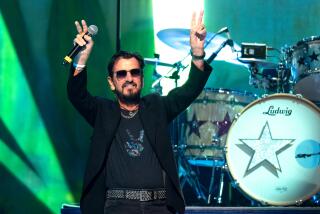Al Viola, 87; longtime L.A. studio guitarist known for work with Frank Sinatra
- Share via
Al Viola, a versatile guitarist best known for his long association with Frank Sinatra and his memorable mandolin playing on “The Godfather” soundtrack, has died. He was 87.
Viola died of cancer Wednesday at his home in Studio City, said his wife, Glenna.
Viola, who arrived in Los Angeles as a member of the Page Cavanaugh Trio after World War II, became a prominent member of the local recording-studio scene.
“He was a chameleon and could play in any style -- that was his great talent,” said jazz singer Judy Chamberlain, a friend who performed with Viola in many settings, including a jazz salute to Sinatra at the Hollywood & Highland Center in 2005.
“He was a flawless player,” she said. “You could barely see his hands move, he was so smooth and quick with his fingers. He was a marvel of dexterity on the guitar, even until the end.”
Said jazz musician Buddy Collette: “Once you played with him, you knew how great he was. He had his own way of playing, his own style; you could tell within a couple of bars who it was. And you could ask him to play anything. He had a background that was unbelievable.”
Sinatra, with whom Viola worked for about 25 years on recordings, TV specials, Las Vegas appearances and concerts, offered his own distinctive praise of Viola during a concert at the Lido in Paris in 1962, which can be heard on the 1994 CD “Sinatra and Sextet: Live in Paris.”
After finishing a free-form vocal-guitar duet of Cole Porter’s “Night and Day” with Viola, Sinatra called him “one of the world’s great guitarists.... I think he plays beautifully. As a matter of fact, if you weren’t looking at him, you’d swear he was an octopus.”
For Viola, the positive feelings were mutual.
“I had to turn down a lot of work to go on a world tour with him for 10 weeks,” Viola told Guitar Player magazine in 1994, “but I liked what he was puttin’ down.”
Viola, whose work with Sinatra took him from the Sands Hotel in Las Vegas to the Parthenon in Athens and beyond, can be heard on such Sinatra hits as “Witchcraft,” “All the Way,” “My Way” and “New York, New York.”
He first met Sinatra after the war when the singer dropped in to hear the Page Cavanaugh Trio in a club on Sunset Boulevard. Sinatra liked them so much, Viola later recalled, that he took the trio to New York with him when he performed at the Waldorf-Astoria, followed by an appearance at the Steel Pier in Atlantic City, N.J.
The trio also did a recording session at Columbia Records with Sinatra, turning out two sides: “That’s How Much I Love You” and “You Can Take My Word for It, Baby.”
After quitting the trio in 1949, Viola remained in Los Angeles and began doing studio work.
He worked in the recording studio -- and occasionally did local gigs -- with the big bands of Harry James, Ray Anthony, Les Brown and Nelson Riddle. He also worked with jazz groups, including playing with Collette, Red Callender, Bobby Troup, Terry Gibbs and Shelly Manne.
“When I was working with Bobby Troup [in the mid-’50s], one of Sinatra’s buddies heard me and told me that Frank needed a guitar player,” Viola recalled in an interview on his website.
“What I enjoyed most about working with Frank is that he was unpredictable,” Viola said. “When I accompanied him, I couldn’t quite predict where he was going, which made it challenging and exciting. He always surprised me on stage. Although he wasn’t known as a jazz singer, he ad-libbed like one and wouldn’t sing a song the same way twice.”
As a studio musician, Viola appeared on more than 500 albums with artists such as Julie London, Steve Lawrence, Marvin Gaye, Neil Diamond, Linda Ronstadt and Natalie Cole.
In addition to being the solo mandolinist who performed the classic “Godfather” theme, he played on numerous TV and film soundtracks, including “West Side Story,” “Who’s Afraid of Virginia Woolf?” and “Blazing Saddles.”
Born in Brooklyn on June 16, 1919, Viola grew up in a large -- and musical -- Italian family whose home was filled with guitars, mandolins and an upright player piano.
“My brother, who played mandolin, needed someone to accompany him, so he taught me a few chords on guitar to play behind him,” Viola recalled on his website.
Teaming up with a violinist friend, they began playing duets in their neighborhood and performed in Chinese restaurants.
“My mother thought I was robbing the bank because I was bringing home $22 a week during the Depression!” he recalled.
While stationed in Sacramento, where he played in an Army band during World War II, Viola and fellow band members Page Cavanaugh and bassist Lloyd Pratt formed the Page Cavanaugh Trio.
After arriving in Los Angeles, the trio played top nightclubs such as the Trocadero and Ciro’s, made a number of records and appeared in several movies.
More than 60 years later, Viola was still playing. His final performance was at Spazio, a jazz supper club in Sherman Oaks, in late January.
“He played great that night too,” Glenna Viola said.
In addition to his wife of 62 years, Viola is survived by his two sons, Dan and Jeff; and a granddaughter.
A funeral service for Viola will be held at 3 p.m. Monday at Church of the Hills, Forest Lawn Memorial-Park, 6300 Forest Lawn Drive, Los Angeles.
*
More to Read
The biggest entertainment stories
Get our big stories about Hollywood, film, television, music, arts, culture and more right in your inbox as soon as they publish.
You may occasionally receive promotional content from the Los Angeles Times.










